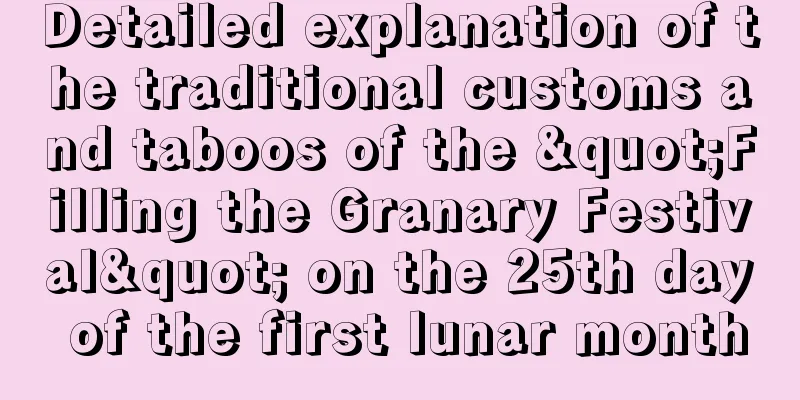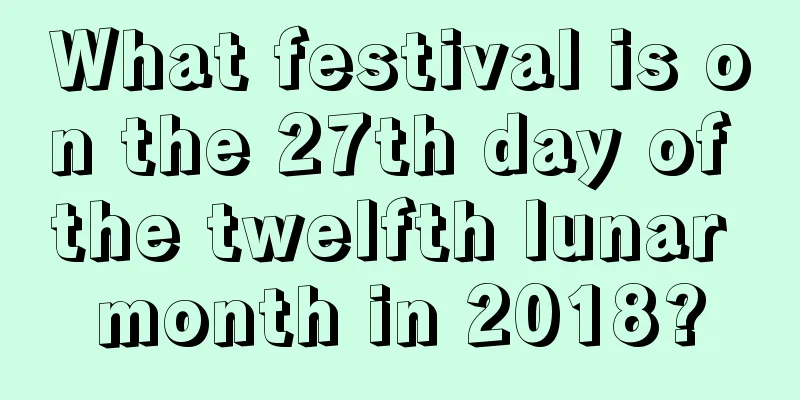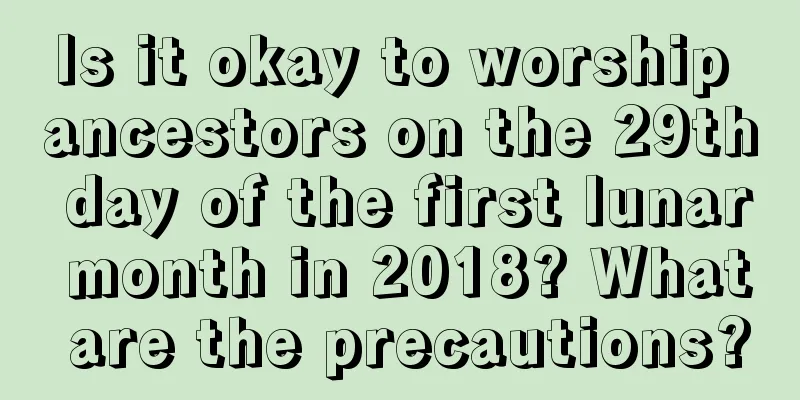Detailed explanation of the traditional customs and taboos of the "Filling the Granary Festival" on the 25th day of the first lunar month

Introduction: Have you heard of the "Tiancang Festival"? There is a folk belief that the 25th day of the first lunar month is the birthday of Lord Cang, so people also call the 25th day of the first lunar month "Filling the Cang Festival". What are the traditional customs and activities on the day of Filling the Granary Festival? Are there any taboos that I should pay attention to? Next, please follow the editor to learn about it! The first month of the lunar calendar is the beginning of spring, and there are beautiful festivals everywhere in this month. Mr. Shui Mo lists these traditional Chinese festivals and customs for you one by one.Introduction to "Filling the Warehouse Festival"The 25th day of the first lunar month, commonly known as the Filling the Granary Festival, is the birthday of Lord Cang. This is a festival among the Han people that symbolizes a good harvest in the new year."Tian Cang Festival" is also called "Tian Cang Festival" because "tian" (fill in Chinese) and "tian" (sky) are homophones of each other. Among the people, there is a distinction between old Tian Cang and small Tian Cang. The 20th day of the first lunar month is Xiaotiancang, and the 25th day of the first lunar month is Laotiancang, which are traditional folk festivals. Some say that Tiancang Festival is the day to worship the stars, while others say it is to worship the land or the god of grinding. To fill the silo means to fill up the barn. Folk Activities of the Filling Granary Festival(1) Making lanterns.Before the festival comes, the family elders usually organize prayers and sacrifices. The day before, people would prepare lamps and wicks for the prayer ceremony. Due to limited conditions, people had to hand-twist cotton paper into lamps and wicks. The folk craftsmanship was exquisite and delicate, like the shape of a small wine cup today, with an opening on the top and a base on the bottom, fixed on an existing lamp stand and lit when in use. After the lamp is lit, the fragrance is lingering and there is no peculiar smell. A small amount of fuel oil or sesame oil can be added from the middle, or fuel can be supplied from the bottom of the rack. The lamps burn all night long, and when the incense oil is used up, it is time to turn off the lights and bring peace to the people. (2) Light the lamp. The number of lamps and wicks to be made should be prepared according to the number of worships to the gods. Generally, three lamps are offered to one deity, and there is also a saying "three for gods and four for ghosts". The lamps should first be placed on the doorposts on both sides of the door gods at the entrance of the house. The door gods are Qin Qiong and Jing De. They should also be placed at the place where Zhong Kui god is on the screen wall facing the door to drive away demons and evil spirits. The place where the gods of heaven and earth are located in the main room should also be decorated, and the altar for all gods in the room should also be lit with incense and lamps. (3) Lanterns are lit in the main hall. The various altars in the large and small halls are all illuminated, which enhances the taste of the festival, creates a solemn atmosphere, and illuminates the steps of the gods when they descend to earth to distribute food. The lanterns are usually lit at night, and the elders and elderly people in the family kneel in front of the tablet of the god on the altar, praying to the gods to distribute food to the people as soon as possible and to protect the safety of the people. (4) Spare food. Before the big and small filling granary festivals, the elders would first arrange to make dough and steam food for the gods. Most of the pasta is shaped like a fairy gourd and is used for offerings. The food kept for one's own consumption emphasizes "changing from white to black", from "white steamed buns" to "black bran nests", reflecting the principles of living frugally and working hard, and returning to a life of clear soup and porridge. This method reminds people not to forget sorrow, suffering, famine and hunger. In addition to ensuring the needs of the upper class, each family has different levels of well-being, and the quality of food and drink varies. Summary: The above article provides us with a detailed analysis of the traditional customs and activities of the "Filling the Granary Festival" on the 25th day of the first lunar month. You can learn about it and feel the cultural charm of traditional festivals and customs! After reading this article, there are more exciting contents in the special topic of the first month of the lunar calendar. Let’s take a look! |
Recommend
What is the fate of a person born on the Double Ninth Festival under the zodiac sign of the Rooster?
What is the fate of a person born on the Double Ni...
It is the beginning of summer in 2020. Can we travel during the epidemic? Will there be a holiday on the beginning of summer in 2020?
Introduction: The day of the Beginning of Summer c...
Is it a good idea to move to a new house on January 1, 2019? Query of auspicious days for moving into a new house in January
Is it a good idea to move to a new house on Januar...
Is it good for a girl born on May 16, 2020, during the Lesser Heat period? Does her horoscope favor earth?
Introduction: New life will also be born during th...
Is it okay to get a marriage certificate on the first day of the fourth lunar month in 2020? Can I get engaged?
Engagement and marriage are major events in life,...
Recommended poems describing the Spring Equinox and introduction to proverbs describing the Spring Equinox
The Spring Equinox is one of the 24 solar terms. S...
Auspicious and inauspicious times for the Lantern Festival on the 15th day of the first lunar month in 2020, countdown to the Lantern Festival 2020!
Introduction: Every day has its good and bad luck,...
Is the day before the Beginning of Autumn in 2020 a good day? Can I swim during the Beginning of Autumn?
Introduction: Every day will have good and bad luc...
What can’t you do during the Ghost Festival in 2019, the Year of the Pig? What is the origin of the Ghost Festival?
Introduction: The Ghost Festival is a very traditi...
Is National Day 2019 a suitable day for getting married? Is it an auspicious day?
The beautiful land is tidied up, and all the peopl...
Is October 28th of the lunar calendar 2021 a good year? Is this day suitable for caesarean section?
The tenth month of the lunar calendar has arrived ...
Is the Lantern Festival also the Torch Festival? Any comment?
Introduction: The Lantern Festival is a very impor...
What day is March 28th in the lunar calendar 2018? What month and date is it?
The arrival of the third month of the lunar calen...
What are the do's and don'ts on the first day of the eighth lunar month in 2017?
August always brings people the sweet scent of os...
Is it a good idea to move house the day before the Rain Water in 2020? How many days are left until the Rain Water solar term in 2020?
Introduction: You also need to choose an auspiciou...









